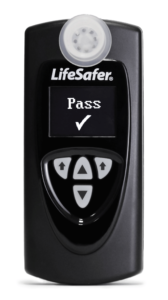In the State of New York, an ignition interlock device (IID) is now required for all alcohol-related convictions, including first-time convictions as well as all misdemeanor and felony driving while intoxicated (DWI) convictions. The IID must be installed and maintained on any and all vehicles the offender owns and/or operates.

Sentencing in cases of DWI will include a requirement that offenders be monitored by the local probation department or if the offender is placed on conditional discharge, the county ignition interlock program.
The IID is connected to the vehicle’s ignition system. Before starting the vehicle, the offender is required to submit a breath sample. If the device detects a breath alcohol content of 0.025 or higher, the vehicle will not start. While the offender is operating the vehicle, the device will require random re-tests, known as “rolling” re-tests. A breath alcohol content of 0.025 or higher during a rolling re-test is recorded by the device as a failed test. IIDs record the number of attempts to start the vehicle, the number of times that the vehicle was started, the alcohol content of the offender’s breath sample, and the amount of time that the vehicle was operated by the offender.
Ignition Interlock Devices
IIDs must be obtained from a service provider that is certified by the State of New York. IIDs are classified by the Division of Probation and Correctional Alternatives. The monitor determines the device classification that is required for the offender and the offender chooses the model within the specific classification. Device classifications include Class I, Class II, and Class III. All devices meet state and federal requirements for IIDs and have data reporting capabilities. Class II IIDs use biometric recognition. Class III IIDs utilize a global positioning system, or GPS, to track the vehicle’s location; report data in real-time, and restrict drive time capabilities.
The device must remain in the vehicle for the period of time determined by the court, for a minimum of six months. For aggravated DWI or in cases of repeat alcohol or drug offenses within five years, the device must remain installed for a period of time equivalent to the revocation period and any probation period.
If the offender is required to operate an employer-owned vehicle within the scope of employment, the offender must submit to the monitor proof that the employer has been notified of the IID requirement. The documentation must include the employer’s permission for the offender to operate the vehicle for business purposes without an IID. The offender may not operate employer-owned vehicles that are owned by a business that is wholly or partially owned by the offender. The owner of any vehicle that is rented, leased, or loaned to the offender must be IID-equipped. The offender must obtain written permission from these individuals granting permission to have the device installed and for the offender to take the vehicle for routine service visits.
The device must be installed within ten days of the offender receiving the court order or if the offender is imprisoned for the DWI offense, within ten days of being released from prison. The offender must submit to the service provider and monitor a photo identification or license, vehicle insurance information including company and policy number, and the vehicle identification number for all vehicles in which IIDs are being installed. If the IID is being installed in a vehicle that is not owned by the offender, the offender must also submit a notarized affidavit from the vehicle’s owner authorizing the installation of the device. Within three days of having the device installed, the offender must submit proof of installation to the court and the county probation department or the county’s designated ignition interlock monitor.
The offender is responsible for any and all costs associated with the ignition interlock device including fees, lease payments, and costs for routine calibration and service visits. The service provider will review the lease agreement and costs with the offender at the time of installation. The court may authorize a payment plan or waive all costs for offenders who can demonstrate that they are financially unable to pay the costs associated with the device.
As New York’s largest ignition interlock device provider, we will work with you to have your device installed within 48 hours. We have many convenient locations throughout New York. We will also work with you to file all of the required legal paperwork.
Additional Resources for the State of New York
Every situation and state is unique, please consult with your attorney or your state licensing authority to confirm your requirements and obligations.
The information provided on this website does not, and is not intended to, constitute legal advice; instead, all information, content, and materials available on this site are for general informational purposes only. Information on this website may not constitute the most up-to-date legal or other information. This website contains links to other third-party websites for the convenience of our readers. Links from Ignition Interlock Help to other sites, or from other sites to the Ignition Interlock Help, do not constitute an endorsement by Ignition Interlock Help.

